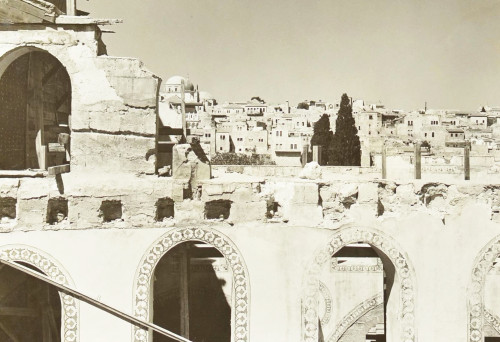
Temple Mount, 1915. Al Aqsa Mosque on the left, Dome of the Rock on the right. The domed Tiferet Yisrael Synagogue is on the horizon between Al Aqsa and the tree. (Photographed by Bernhard Moritz, Library of Congress1 and Ottoman Imperial Archives )
A Photographic Essay of the Secrets Under the Al-Aqsa Mosque
By
h/t to David Bedein @Israel Behind the News
In his interview with Israel’s Channel 2, the Mufti also insisted that there never was a Jewish Temple or shrine atop the Temple Mount.3
Short History Lesson
Jews believe that the “foundation rock” beneath the Dome of the Rock is atop Mt. Moriah, the site of the binding of Isaac. King Solomon built his Temple upon the rock in the tenth century before the Common Era (BCE), but it was destroyed in 587 BCE by the Babylonian King Nebuchadnezzar. Seventy years later, the second Temple was built by Jews returning from Babylon with King Cyrus’s blessing. Years later it was rededicated by the Maccabees in approximately 160 BCE after its defiling by the Seleucids.
In the first century BCE, the Second Temple, built by the returnees from Babylon, was rebuilt and massively expanded by King Herod. To accommodate the large Temple building and administrative offices, the Mt. Moriah plateau was expanded to become a colossal platform with huge retaining walls. The Western Wall, the prayer site for Jews over the centuries, was part of the retaining walls. Roman armies commanded by Titus destroyed the Temple in 70 CE.
Muslims believe that Muhammed (570 – 632 CE) was transported on a heavenly creature from Mecca to the Al Aqsa Mosque and then to heaven in his “Night Journey.” The mosque was constructed in the late seventh century CE and rebuilt several times after major earthquakes destroyed it.
The golden Dome of the Rock is a shrine built over the foundation stone in 691 CE.
The Crusaders captured Jerusalem and the Temple Mount in 1099 and converted the Al Aqsa Mosque into a palace and the Dome of the Rock into a church. Saladin captured Jerusalem in 1187 and restored the mosque.
The 1927 Earthquake Revealed More about the Mosque
The current Mufti surely knows that the Al Aqsa Mosque suffered a major collapse during an earthquake in 1927. Renovation took several years, and in that period at least two Christian photographers, including British archeologist Robert Hamilton, ventured into and under the mosque. Hamilton, from the British Archaeological Authority, “photographed, sketched, excavated and analyzed” what he saw, according to Nadav Shragai, a scholar on Jerusalem, writing in Yisrael HaYom.4 But Hamilton promised the Islamic Authorities, the Waqf, that he would make “no mention of any findings that the Muslims would have found inconvenient” such as findings from the time of the Jewish Temples. The photographers documented the mosaics, passageways, cisterns, and lumber that apparently were part of the Temples.
Many of Hamilton’s photos may be viewed today on the site of the British Authority’s successor, the Israel Antiquities Authority.5 Other pictures may be found in the Library of Congress’ archives of the American Colony photographers.

After collapse of the roof of Al Aqsa, only the rafters remained. Analyses of the beams showed they were cedar and cypress wood; carbon dating showed some dated back more than 2,000 years, suggesting they had been used in earlier structures.6 In the top picture the Porat Yosef Yeshiva with its white dome can be seen on the right. It was destroyed by the Jordanians in 1948.
(Israel Antiquities Authority Archives)
Many of these sites and structures may have been destroyed in recent years by the Waqf’s (Muslim Council) bulldozers during their construction of subterranean mosques under the Temple Mount. Fortunately, photographs still exist and were digitized by archivists so we can document what were probably parts of the Jewish Temple complex and what the Mufti denies.
* * *
Notes
* * *
Lenny Ben-David publishes www.israeldailypicture.com where many of these pictures first appeared














